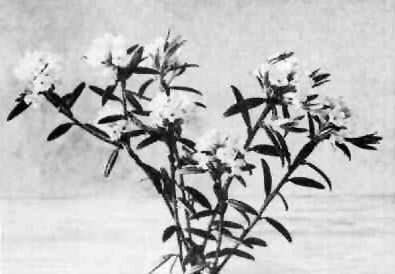QBARS - v3n1 Rhododendron trichostomum var. ledoides
Rhododendron trichostomum var. ledoides
P. H. Brydon

|
|
R. trichostomum
var.
ledoides
Photo by P. H. Brydon |
The plant in the accompanying illustration was grown from seed received from the Royal Botanic Garden, Edinburgh, as R. ledoides . As such it therefore belonged in the Cephalanthum Series. However, Cowan and Davidian in their revision of the Anthopogon and Cephalanthum Series published in the 1947 Rhododendron Year Book, R. H. S. have relegated this species to varietal rank and it is now properly referred to as R. trichostomum var. ledoides . Also two near relatives have been renamed. First, R. sphaeranthum , which for all practical purposes was indistinguishable from R. ledoides , has been reduced to synonymity with R. trichostomum ; and second, R. radinum is now R. trichostomum var. radinum . This is an important piece of research since the line of demarcation between certain species is quite vague and, in many cases, specific rank has been accorded where the plants in question are merely variants of the type. As an illustration of the close alliance of the three above mentioned species, Dr. Cowan states "when seed of R. radinum is sown we are likely to raise seedlings not only of R. radinum but also of R. ledoides and R. sphaeranthum."
Its native habitat is in the Province of Yunnan in S. W. China. Like many other rhododendrons, it loves the company of its fellows and occurs in communities which cover large areas in the highlands of N. W. Yunnan at -altitudes of from 10,000 to 13,000 feet. Captain Kingdom Ward describes an association of this species with Pines and other low growing rhododendrons as follows: "Thousands of square miles of mountainous country are clothed with this Pine park swamped in an ocean of rhododendron undergrowth and June flowers."
Under cultivation it is a small shrub with an open twiggy habit and eventually reaches a height of 3 feet. The foliage and young branches are covered with reddish scales and are quite aromatic when crushed. The dark green leaves vary from ¾ to 1¼ inches in length and from 1/5 to ⅓ inches in width. A well established plant in full bloom is reminiscent of Daphne cneorum with its terminal rounded trusses of fragrant pale rose flowers. The individual truss is about 1½ inches in diameter. The flowers appear about mid April in the San Francisco region which would indicate that this species might bloom in early May in the Northwest. It is not fastidious as to cultivation and makes an ideal evergreen shrublet for the rock garden.
